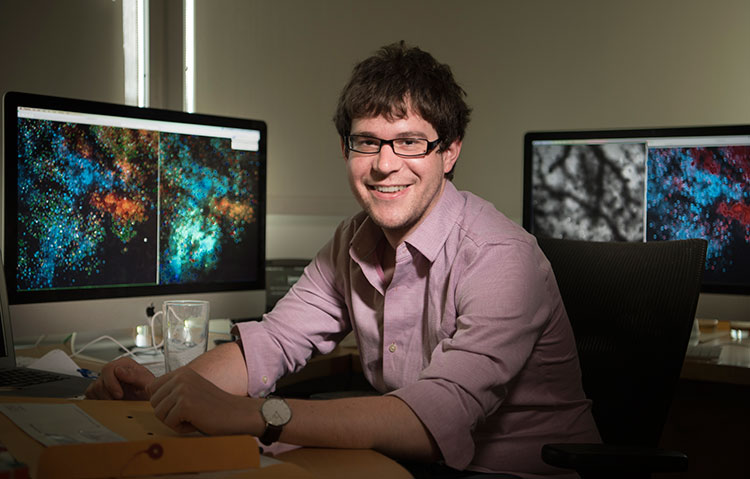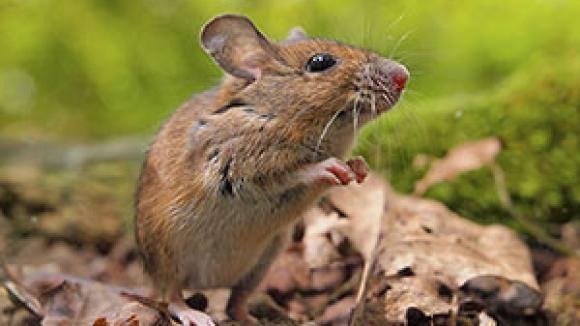
Photograph by James Kegley.
Jeremy Freeman is a computational neuroscientist. He builds mathematical models that help researchers understand their data and plan their experiments. But that doesn’t mean he just crunches numbers in isolation. “If people handed me data, and I went away for six months and analyzed it, it would be boring,” he explains. “That’s not really the way to progress. You need to be constantly interacting and finding cool stuff in the data together.”
Freeman likes to immerse himself in his collaborators’ experiments, learning how the experiments are done, looking at the data, and figuring out what is or isn’t possible.
Janelia provides Freeman with ample opportunity to build such relationships. “Everyone is open to looking at experimental data with others. Janelians want to collaborate,” he says. “If I sit by the coffee machine all day, I’ll have a chance to talk with all of my collaborators – and probably end up with new ones.”
Freeman came to Janelia in 2013 as a junior fellow. In the three years since, he has begun collaborating with a number of Janelia group leaders, including Misha Ahrens, Philipp Keller, and Loren Looger.
One major area of focus for Freeman today is his collaboration with Karel Svoboda’s lab group. That partnership started the way many of his others have: a scientist, in this case graduate student Nick Sofroniew, asked Freeman to help make sense of some data.
Sofroniew had developed a tactile virtual reality (VR) system for mice – a spherical ball with two motorized walls that mimics the subterranean passageways mice like to frequent. Rodents have the ability to use their whiskers as a second set of eyes, palpating objects with the stiff hairs to gather information about shape, texture, and location. By placing a mouse on the spherical ball and stimulating its whiskers with the mobile walls, Sofroniew could record the animal’s brain activity to learn how it uses its whiskers to explore the world.
“When Nick started explaining his VR system, it immediately resonated with me,” recalls Freeman. “It was something natural but also something he had total control over. I thought it was just beautiful.” The pair began poring over neural and behavioral data from the VR rig, formulating models and characterizing the role of neurons involved in whisker-guided locomotion. Now, they are trying to do analysis in real time, using responses from the mouse’s brain to change the nature of an experiment in the moment.
Freeman and Sofroniew are also actively expanding the VR system to study more complicated behaviors. They added a pivoting third wall in the path of the mouse, creating either the illusion of a dead end or a decision point. “The system is like a ballet of motors,” says Freeman.
Learn more about the tactile virtual reality system in this video from the BBC.
Sofroniew has also increased the system’s capacity to monitor brain activity by adding a large-field, high-resolution microscope to the rig. The “mesoscope,” built by Sofroniew and his colleagues in the Svoboda lab and Janelia’s Instrument Design and Fabrication facility, provides high-resolution views of multiple regions of the brain. “In the past, we could only look at a very small portion of the somatosensory cortex,” says Freeman. “Now we can see the motor areas, sensory areas, and parietal areas simultaneously.” This allows them to watch neurons involved in behavior, sensation, decision making, learning, and memory, all at the same time.
As their collaboration evolved, Freeman and Sofroniew’s roles shifted as well. A few years ago, Freeman became a group leader and is now mentoring Sofroniew, who is a joint postdoc in the Svoboda and Freeman labs. The pair’s relationship has grown too – Freeman says they’ve become good friends who share a scientific vision.
This isn’t unusual for Freeman, who counts his collaborators among his closest friends. “I really believe that establishing a computational collaboration starts with making a personal connection,” he explains. “I don’t think it’s a surprise that most of the great discoveries in science have two or more names attached to them, and that will only continue as we tackle larger and more complex problems – together.”
Stories of Collaboration
Collaboration between labs, project teams, support teams, and scientists at other institutions is an essential part of the culture and intellectual life at Janelia.


